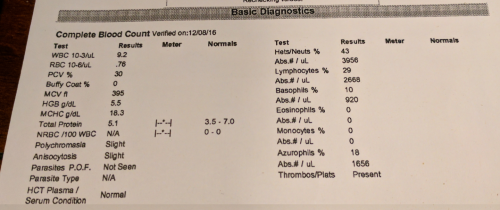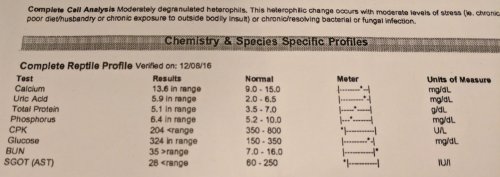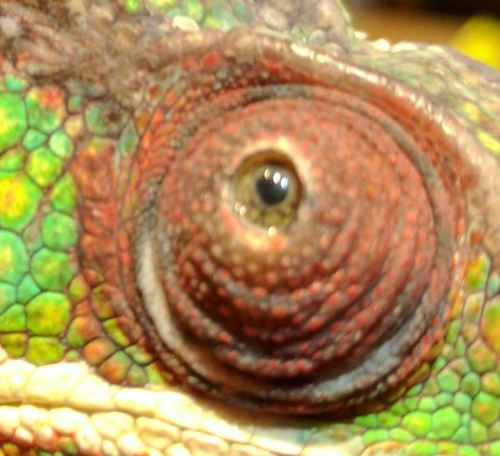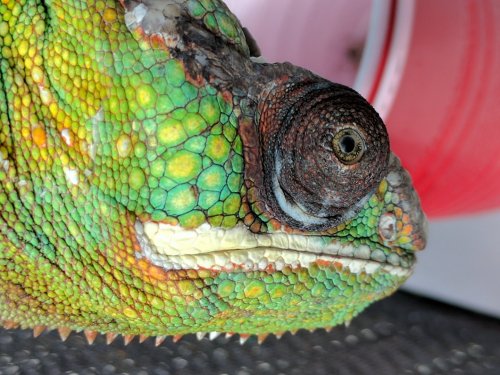Thegreatfonz
Member
Hello my favorite chameleon friends!
Chameleon Info:
Cage Info:
Current Problem -
Renley has been in and out of the vet a decent amount recently. It started close to two months ago where he was extremely lethargic, dull colored and was weak and falling from branches. I took him to his vet and he was put on a round of antibiotics including baytril, eye drops including flurbiprofen with his antibodies added to it and gentamicin sulfate. And then I also had to give him shots every 3 days of ceftazidime/fortaz. Both of his eyes had this grayish ring around the cornea at this time as well. These medications got him back to normal and the grayish rings around his corneas diminished. He gained over 20 grams between getting him back on medication and his checkup. During the time between the two rounds of blood work he went into the vet twice a week for three weeks to receive fluids to help flush out his kidneys. Now it seems as though his vision is off. He's having trouble targeting crickets and even worms. His right eye now looks off and has some kind of clear film over it. When we went in to receive his blood work the vet gave us another round of flurbiprofen and we have been giving those drops to him for the past week, but they do not seem to be helping fix the problem. We discussed his blood work with the vet, and he recommended another round of baytril and shots to help continue his path back to health. We decided to wait it out and see how he reacted to the horn worms and the flurbiprofen. We would really like a second opinion regarding his blood work, and what do to about his continuing eye problems. He just went through a shed, his colors have been vibrant and beautiful, our concern is focused on his eyes.
Here are pictures of his bloodwork:



Here is his bad eye.

Chameleon Info:
- Your Chameleon -Male panther chameleon. 4 years old now. In my care for 3yr 9months.
- Handling -He's handled close to every day.
- Feeding - Crickets are his main source of food. He'll eat 6-8 large crickets on a good day. He sometimes gets horns and silks but I only order those every 4-5 months maybe. I try to feed him everyday because he will be more active when he eats. I gut load with oranges, carrots, sweet potato mostly. Sometimes raspberries and blueberries. Then I alternate dry gutloads using repashy superload one week and then cricket crack the next.
- Supplements - I use cal w/o d3 every other day. Cal with d3 once every 2 weeks.
- Watering - He drinks from a dripper that falls into a cap with a leaf attached. He's been drinking like this for at least 2 years now. He hasn't been drinking as much from it lately though which concerns me. I try to mist 2-3 times a day by hand. I just moved and have not found a great place to set up the mist king and cage. Like I said earlier I haven't seen him drinking as much lately, and when he does it has been irregular. Therefore, I bought a pod of hornworms and he's eaten those this week and he's definitely hydrated.
- Fecal Description - White urate. Recent poop has been runny because of the horns. He does not have parasites. He used to poop every 2-3 days but now it's become pretty irregular.
- History - Here's the fun part. So last December he had a large bump in the area around his cloaca. I took him to an exotic vet who's become his primary doctor basically and it was found that Ren had a ruptured hemipene. This hemipene then became massively infected and the area around it was infected as well. The vet removed the hemipene and any surrounding necrotic/infected tissue as well. Ren was back to normal after the surgery and a round of medicine. He's had some eye problems since then but they cleared up and then eventually went away but he's seemed prone to bacterial infections in my opinion.
Cage Info:
- Cage Type - Screen 2x2x4
- Lighting - I have a 100w basking lamp and a dual fixture T5 and grow light from Todd.
- Temperature - Temp in his basking spot is around 90-94F. I try to keep it on the hotter side because I really don't see him bask under it much. I always figured it must not be hot enough for him which is why I moved from a 75W to a 100W bulb. Lowest overnight temp is probably 73F. I use a temp probe to measure the temperatures.
- Humidity - Humidity is probably 40%. I'm in Florida so its naturally humid here. Temp probe has a humidity gauge as well.
- Plants - Live pothos in the large cage.
- Placement - He's got two cages. One outside where I place in the sun and one inside. He basically stays outside from 11am-4pm when there's sun. Then he basically just sleeps in the large cage.
- Location - South Florida
Current Problem -
Renley has been in and out of the vet a decent amount recently. It started close to two months ago where he was extremely lethargic, dull colored and was weak and falling from branches. I took him to his vet and he was put on a round of antibiotics including baytril, eye drops including flurbiprofen with his antibodies added to it and gentamicin sulfate. And then I also had to give him shots every 3 days of ceftazidime/fortaz. Both of his eyes had this grayish ring around the cornea at this time as well. These medications got him back to normal and the grayish rings around his corneas diminished. He gained over 20 grams between getting him back on medication and his checkup. During the time between the two rounds of blood work he went into the vet twice a week for three weeks to receive fluids to help flush out his kidneys. Now it seems as though his vision is off. He's having trouble targeting crickets and even worms. His right eye now looks off and has some kind of clear film over it. When we went in to receive his blood work the vet gave us another round of flurbiprofen and we have been giving those drops to him for the past week, but they do not seem to be helping fix the problem. We discussed his blood work with the vet, and he recommended another round of baytril and shots to help continue his path back to health. We decided to wait it out and see how he reacted to the horn worms and the flurbiprofen. We would really like a second opinion regarding his blood work, and what do to about his continuing eye problems. He just went through a shed, his colors have been vibrant and beautiful, our concern is focused on his eyes.
Here are pictures of his bloodwork:



Here is his bad eye.





